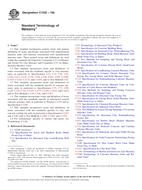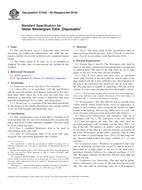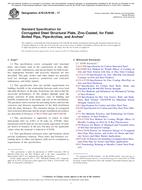1.1 This test method covers the estimation of the net heat of combustion at constant pressure in metric (SI) units, megajoules per kilogram.
1.2 This test method is purely empirical, and it is applicable only to liquid hydrocarbon fuels derived by normal refining processes from conventional crude oil which conform to the requirements of specifications for aviation gasolines or aircraft turbine and jet engine fuels of limited boiling ranges and compositions as described in Note 1.
Note 1 – The estimation of the net heat of combustion of a hydrocarbon fuel from its aniline point temperature and density is justifiable only when the fuel belongs to a well-defined class for which a relationship between these quantities has been derived from accurate experimental measurements on representative samples of that class. Even in this class, the possibility that the estimates can be in error by large amounts for individual fuels should be recognized. The JP-8 fuel, although not experimentally tested, has properties similar to JP-5 and Jet A fuels and can be considered in the same class. The classes of fuels used to establish the correlation presented in this test method are represented by the following applications:
| Fuel | Specification |
| Aviation gasoline fuels: | Specification D910 |
| Grades 80, 82, 100/130, and 115/145 | Specification D6227 |
| DEF STAN 91–90 | |
| NATO Code F-18 | |
| Aviation turbine fuels: | MIL-DTL-5624 |
| JP-4, Avtag/FSII | DEF STAN 91–88 |
| NATO Code F-40 | |
| JP-5, Avcat/FSII | MIL-DTL-5624 |
| DEF STAN 91–86 | |
| NATO Code F-44 | |
| JP-8, Avtur/FSII | MIL-DTL-83133 |
| DEF STAN 91–87 | |
| NATO Code F-34 | |
| Jet A, Jet A-1, Avtur | Specification D1655 |
| DEF STAN 91–91 | |
| NATO Code F-35 |
1.3 The net heat of combustion can also be estimated by Test Method D1405. Test Method D1405 requires calculation of one of four equations dependent on the fuel type with the precision equivalent to that of this test method.
1.4 The values stated in SI units are to be regarded as standard. No other units of measurement are included in this standard.
1.5 This standard does not purport to address all of the safety concerns, if any, associated with its use. It is the responsibility of the user of this standard to establish appropriate safety and health practices and determine the applicability of regulatory limitations prior to use.
Product Details
- Published:
- 12/01/2011
- Number of Pages:
- 4
- File Size:
- 1 file , 96 KB


